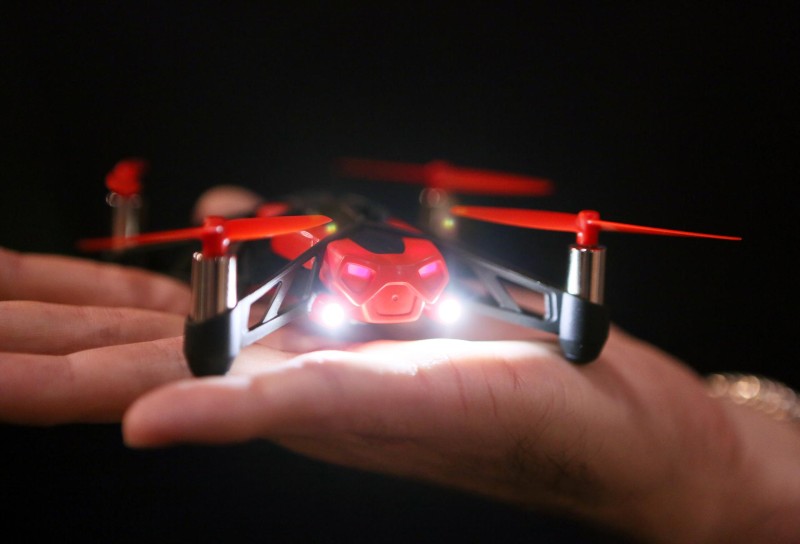LAS VEGAS — Too bad I can’t use a drone to help me cover the International CES, the giant consumer electronics show. With its high ceilings, the Las Vegas Convention Center provides plenty of airspace. And I might actually get to see everything, for a change.
But there’s no indoor flying here, except in special zones fenced off with nylon nets. The drone makers are fine with this sensible precaution. But they’re losing patience with federal rules that are crippling the US drone market.
For the first time, the CES this year gave unmanned aircraft their own special area on the show floor, and no wonder. Worldwide, demand for civilian drones is surging. Aviation analysts at Teal Group figure that $10 billion will be spent on them worldwide over the next decade. But the Federal Aviation Administration is taking its sweet time drawing up regulations to govern drone use. Hence the annoyance among drone vendors who would otherwise be having the time of their lives.
They are running late,” said Yannick Levy, executive vice president of Parrot, a French company that is one of the world’s top drone makers. The FAA was supposed to propose guidelines last year. Now they are expected in the next few weeks. Even then, public comments and revisions will follow. The process could stretch into 2016 and beyond.
Meanwhile, hundreds of drones are at work outside of the United States, inspecting railroads and electric power lines, mapping farmland, and surveying real estate. The German package-delivery company DHL uses them to make regular runs to an island in the North Sea. America’s military drones taught the world how to make robots fly. But in commercial applications, Europe is taking the lead.
Still, this is a consumer electronics show, and American hobbyists are snapping up drones by the thousands. Many of them are manufactured by Parrot, which made its name building car electronics. Levy said the company wanted to dabble in radio-controlled toys, but miniature cars seemed boring. So it opted for a flying machine. The result was the AR Drone, a one-pound, four-rotor helicopter with a built-in video camera. Parrot has sold 750,000 of them, and its drone business brings in more revenue than the automotive gear.
At the CES, Parrot showed off the Bebop, a quadricopter that seems underpriced at $499. The Bebop can act as a flying Wi-Fi hot spot. The high-definition camera in the nose features near-perfect image stabilization. One Bebop was mounted on a mechanical platform that rocked it sharply up and down, but the camera image, displayed on a nearby tablet, barely moved. Filmmakers should buy hundreds of these.
But they will need a special FAA dispensation to use them. In the United States, it is legal to fly drones as a hobby, as long as you follow some simple rules. For example, you can’t go above 400 feet, you must keep the drone within sight, and you’re not supposed to fly near airports or over large groups of people. But here’s the strictest rule: You can’t fly drones for money. If my photographer wife uses a camera-equipped drone to shoot our church picnic, no problem. If she’s paid to get aerial shots of a wedding party, look out.
“If someone can make sense of this, I’m open to hearing it,” said Michael Drobac, executive director of the Small UAV Coalition, a tech industry group that’s urging the FAA to loosen up.
Spokesman Ian Gregor said the FAA is granting case-by-case exemptions for commercial drone use, with 14 issued so far. “We are introducing unmanned aircraft into America’s airspace incrementally and with the interest of safety first,” he said.
Indeed, if drones aren’t used safely, the skies could rain robots. Parrot accidentally proved that with its CES floor show Tuesday. Six Bebop drones emerged from behind red curtains and began an automated dance, hovering and swooping, missing each other by inches.
Then came a clattering crash. A drone had fallen to the floor. I’m not sure whether it clipped one of its fellow dancers or bumped the safety net surrounding the stage. Either way, the show went on.
Imagine a flock of package-delivery drones slamming into each other over the Back Bay, and you can see why the FAA is nervous.
Still, there are plenty of missions where commercial drones could be safely used right now. I wish journalism was one of them.
Hiawatha Bray can be reached at hiawatha.bray@globe.com. Follow him
on Twitter @GlobeTechLab.
